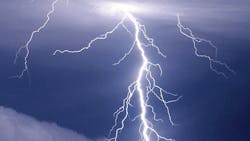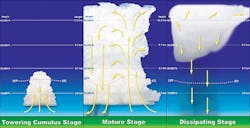Storm Safety: Thunderstorm and Lightning Preparedness
The warm, humid conditions of the spring and summer seasons greatly favor the development of thunderstorms, though thunderstorms can occur at any time of year. Thunderstorms may occur singly, in clusters or in lines and usually only produce heavy rain for a brief period of time ranging from 30 minutes to an hour. However, the most severe thunderstorms can affect one location for an extended period of time. At any given time, nearly 1,800 thunderstorms simultaneously are occurring on Earth (American Red Cross, 2012), and can develop into conditions such as tornadoes and damaging hail. Lightning strikes can be fatal, and there also is a variety of permanent injuries employees can develop as a result of a lightning strike. These injuries can include – but are not limited to – muscle spasms, chronic pain, sleep disorders, memory loss and fatigue (National Weather Service [NWS], 2012). According to NWS, lightning kills more than 70 people and injures at least 300 others each year in the United States. In 2012, there have been at least five reported fatalities attributed to lightning strikes in the United States.
Due to the immense amounts of rainfall that can occur during thunderstorms, flash flooding also accounts for roughly 140 fatalities each year in the United States, according to the Federal Emergency Management Agency (FEMA). The deaths that occur during flash flooding are greater than any other hazard associated with thunderstorms. And the destruction due to thunderstorms does not stop there. When severe high winds are present, homes and automobiles also can be damaged. High winds can knock down trees and utility poles, which can cause extensive power outages and account for a handful of deaths each year.
How Thunderstorms and Lightning Develop
As thunderstorms progress, they go through a series of stages that can be described as development, mature /growth, electrification and dissipation. Pockets of warmer air begin to rise into the atmosphere early in the day, due to the sun heating the air near the ground. These pockets of air then begin to form cumulus clouds. The formation of these clouds may be the first sign that a thunderstorm is developing. The final stage of development occurs as the cloud cools to a point where it may no longer rise and is forced to spread out, which is what gives these clouds their anvil shape.
As other warm air continues to rise, the cloud continues to grow and precipitation begins to form within the thunderstorm cloud. Well-developed thunderstorm clouds contain minute ice crystals in the upper levels of the cloud, a mixture of ice crystals and small hail in the middle levels of the cloud and a mixture of rain and melting hail in the lower levels of the cloud. These various types of precipitation collide due to air movement in the middle of the cloud and cause the precipitation particles to become charged. Lighter ice crystals develop a positive charge and are carried by updrafts into the upper part of the storm. A negative charge is then developed by the heavier hail, and is either suspended in the air by the updrafts or falls toward the lower part of the storm.
Air between the positive and negative charges in the cloud acts as an insulator, but the differences in charges become too great at times, which results in a breakdown of the insulating capacity of the air. Lightning is created as the charges in the air are broken down and result in a rapid release of electricity. Lightning can move in many more ways than just from clouds into contact with the ground; lightning also can move from cloud-to-cloud, within a cloud or cloud-to-air.
Safety for the Workplace
Thunderstorms and lightning can be a significant issue for employees working outdoors. The risk of being struck by lightning increases when individuals are outdoors near isolated tall objects, in open spaces and close to metal objects. Proper thunderstorm and lightning safety procedures or guidelines should be contained in an emergency action plan, which should address several areas, such as:
- A chain of command;
- A means of monitoring weather conditions;
- A list of designated safe sites to take shelter;
- Criteria for suspension and resumption of work; and
- The use of recommended safety strategies.
Safety Precautions
A person’s chance of being struck by lightning are estimated to be 1 in 600,000 by FEMA, but can be reduced by following some proper safety precautions. If you are isolated and your hair stands on end (which indicates that lightning is about to strike), then crouch low to the ground on the balls of your feet. Place your hands on your knees and your head between your knees to minimize your body’s surface area and minimize your contact with the ground. Lightning current often enters a victim through the ground rather than by a direct, overhead strike. Keep safety in mind when a thunderstorm begins to stir – know how to prepare before, during and after a thunderstorm.
It is important to establish a section of the emergency action plan that prepares workers for the appropriate action to take during a thunderstorm. All workers should be trained on these procedures so they know how to properly respond to an approaching thunderstorm. Consider these safety measures to be prepared for thunderstorms:
- Monitor the daily weather forecast to be aware of thunder- storm watches and warnings.
- Know the signs that a thunder- storm is approaching; listen for thunder in the distance and look for dark clouds, rain, high winds and lightning.
- Follow all company procedures regarding working outdoors during thunderstorms.
- Remove any dead or rotting tree branches that could fall and cause injury or damage.
- Postpone any outdoor work, if possible, when a thunderstorm is nearby.
- Secure outdoor objects that could blow away.
Even when inside a safe shelter, be cautious during thunderstorms. Keep informed on the weather forecast, avoid using electrical equipment and corded telephones if possible and unplug any electronic equipment. Keep away from plumbing and bathroom fixtures as they can conduct electricity. While driving, if it begins to hail or rain heavily during a thunderstorm, safely pull over to the side of the road, turn on the emergency flashers and park the vehicle until the storm calms down.
The best way to protect yourself from thunderstorms is to avoid the threat. If you are caught outside during a thunderstorm, take shelter in a substantial, permanent, enclosed structure that contains plumbing or wiring (i.e., such as a home, office building, school, church, or shopping center). If such a place is unavailable, then select an enclosed metal vehicle for a suitable shelter. Do not seek shelter in open areas, on high grounds, under tall isolated objects (trees, poles), under picnic shelters, in carports, tents or near materials that can conduct electricity (metal objects, utility lines and water). Make sure the place you choose for shelter is not prone to flooding during heavy rains, and go to a low-lying, open place, away from trees, poles and metal objects that is not susceptible to flooding when no other safe cover is available.
After a Thunderstorm
Safety still is a priority after a thunderstorm. Remember to follow the 30/30 rule. This rule is important to follow because 50 percent of lightning-related injuries happen after the thunderstorm has passed. After seeing lightning, go indoors if you cannot count to 30 before hearing thunder. Stay indoors for 30 minutes after hearing the last clap of thunder. Continue to monitor the weather for storm updates by listening to a local radio station or television station. Use generators outdoors and on a flat level surface if a power outage occurs to avoid exposure to carbon monoxide. Stay away from any downed power lines and areas damaged by the storm.
Assist others if they have been struck by lightning or need help. Call your local emergency number and remember, people who have been struck by lightning do not carry electrical charge and are safe to handle and assist. Give first aid; if breathing has stopped, begin rescue breathing, and if the heart has stopped beating, a trained person should give cardiopulmonary resuscitation (CPR).
Thunderstorms and lightning are more prevalent during warm and humid conditions, but still can arise during any other time of year. Taking the necessary steps to prepare yourself before, during and after a thunderstorm will help to ensure your safety and the safety of others.


